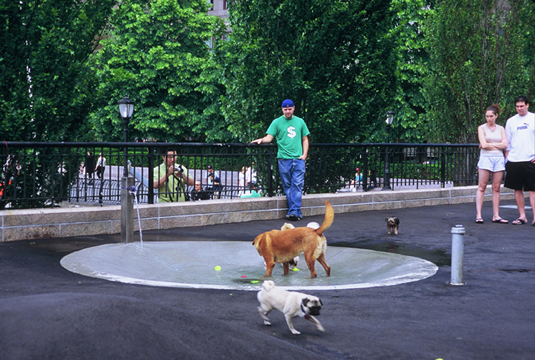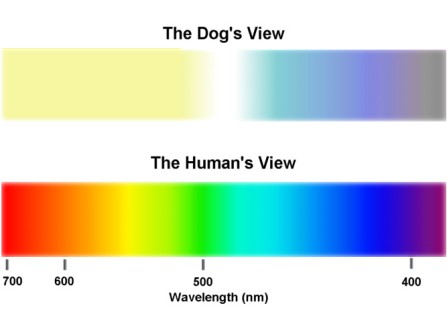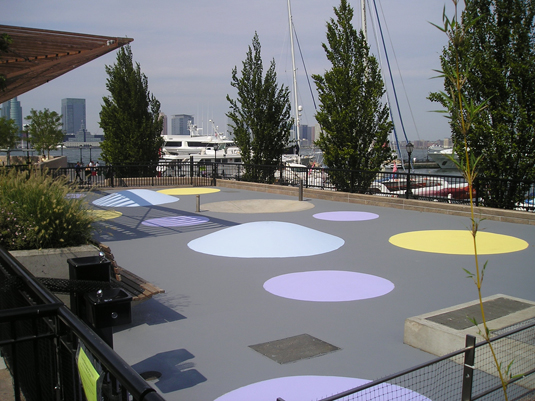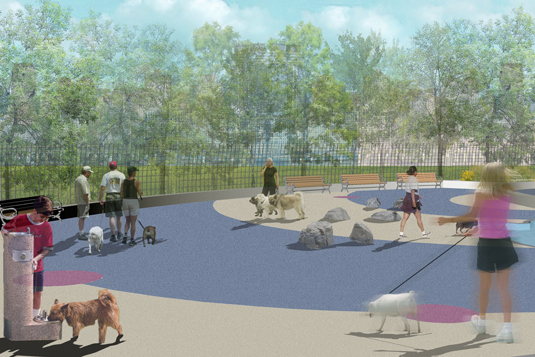
August 29, 2012
The Green Team Part 2: Colors Only Your Dog Can See
Parks are not just for people they’re for pets, too!
In our first blog, The Green Team Part 1, we introduced you to our green research team and how we approach landscape design in the urban environment—for humans. This post reflects on design for another city resident: man’s and woman’s best friend.
Designing for the Dogs
Parks are not just for people—they are for pets, too! With the number of pet owners reaching record numbers in the U.S.—79 dogs for every 100 households according to Gallup, and with more people moving to cities than ever before, urban dwellers need public outdoor spaces for their pets. The growing urban population is embracing dog runs as an important component to the recreational quality of a park. In addition to giving their pets a place to romp, city parks also bring dog owners together.
Most dog parks evolve around a simple idea: find an open space, fence it in, let dogs run. Unfortunately, finding that patch of grass is not so simple in densely built urban areas. This has resulted in the evolution of dog runs, beyond simple mulch and fence to solid surfaces.
When we were approached to design a dog run for the Tribeca section of Hudson River Park, our green team went into action. We built on the research from previously designed dog runs at West Thames Park and Battery Park City to develop applicable design criteria for a durable, practical solution to enhance the canine experience, benefitting both pet and pet owner.

Pups at play at Kowsky Park’s dog run in Battery Park City.
Courtesy Mathews Nielsen
Considering the Dog’s Perspective
Drawing on design inspiration from our four-legged friends, the team felt it was important to design through the primary user’s eyes. A typical pup has an eye level of 12 to 36 inches—clearly, they see the world from a different perspective than humans who have an average eye-height of 60 inches.
This led to a broader, universal question: What do dogs actually see? The answer: More than we think!
Dogs are colorblind, aren’t they?
A common misconception is that dogs cannot see in color. But according to studies completed by the Medical Veterinary Association, dogs do see color, in a more limited palette than humans do. Rather than perceiving the typical ROYGBIV color spectrum, dogs are limited to shades of yellow, blue, and gray, but are able to discern subtle gradient changes within this color range. In addition to these colors, dogs are able to recognize texture, shape, and silhouette.

A comparison of color perception between dogs and humans.
Courtesy Mark Plonsky, Ph.D
As landscape architects, we often think of ways to manipulate ground layer materials to enhance the aesthetic experience while providing a functional design. Because the dog’s eye view is keenly anchored to the ground layer, we chose to focus our efforts on the paving treatment. Asphalt appeared to be a viable solution. It’s easy to maintain through power washing. But how could we manipulate this monolithic, dark surface into a material that would be more dog friendly? How could we play on materials? Could we incorporate various textures, shapes, and colors into dog-specific site elements? If bike lanes are painted green for safety, why not explore similar painting treatments that dogs can discern?

Color treatments were first explored by MNLA during the design of the Kowsky Park Dog Run in Battery Park City.
Courtesy Mathews Nielsen
Barking up the Right Tree
Building on a unique application of Streetbond, a typical asphalt paint product, we were able to incorporate a selection of colors into the dog run’s paving design that dogs can recognize. Similar to a children’s play area, the design uses bold shapes and sweeping forms of yellow and blue that extend into the surrounding landscape. These colors provide an aesthetic connection to the park. And because these colors have a high solar reflectance, they help reduce the paving’s surface temperature. This coating also adds a textural element for slip resistance without being abrasive, protecting Fido’s paws.

Photo montage showing the proposed ground plane treatment at the dog run within Hudson River Park, Tribeca Section.
Courtesy Mathews Nielsen
Ground plane is only one aspect we use to enhance the user experience in the design. Other site-specific elements that appeal to dogs are also integrated into the layout of the park: dog-activated water features, themed drinking fountains, and boulders of various sizes for play.
The anticipated completion date of our project is summer 2013. We hope you’ll come by to see our canine users in action, and their human companions, too! Our next blog will take us to the South Bronx, where we cleaned up the industrial soil on a blighted site, giving it new life for our latest project there.
Check out more posts from the Green Team.
Lisa DuRussel, RLA, ASLA, LEED AP is a Midwestern transplant, avid coffee drinker, soils enthusiast and practicing landscape architect in New York City. Since receiving her BS and MLA from the University of Michigan, she has worked on numerous urban revitalization and cultural landscape projects in the New York and Chicago areas, including the Governors Island Park and Public Space project.
This is one in a series of Metropolis blogs written by members of Mathews Nielsen’s Green Team, which focuses on research as the groundswell of effective landscape design and implementation. Addressing the design challenges the Green Team encounters and how it resolves them, the series will share the team’s research in response to project constraints and questions that emerge, revealing their solutions. Along the way, the team will also share its knowledge about plants, geography, stormwater, sustainability, materials, and more.
References and Links:
Coren, Stanley.“Can Dogs See Colors?” Canine Corner, 2008.
Miller, P and Murphy, C. “Vision in Dogs” Journal of the Veterinary Medical Association. 1995
Wynns, K. Video: “A Beautiful Day at the Dog Park.”





